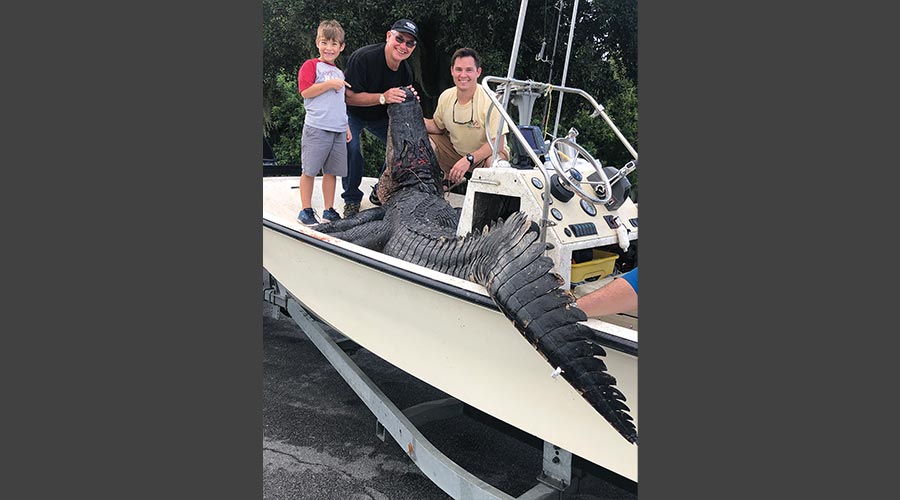
Alligator hunting is one of those pursuits that sounds like a movie plot, until talking with Paul Owens, owner and president of Gem Supply Company, an Orlando-based distributor with locations throughout Florida. To Paul, it’s an average weekend: To catch a 12-foot, 500-pound alligator, head to a Florida lake with some other strong people. Find and bait a gator. Tire it out, harvest it, and get it into the boat. Then drive it to the meat processor who buys it and sells the meat and hide.
Hunting gators is a multi-generational thing in the Owens family. Paul hunts with his dad, Dutch — now retired from Gem Supply — and son Hoke, who participates but is currently more of a spectator.
“I grew up hunting normal things, like deer and turkeys,” Paul recalls. “About 17 years ago, a friend of a friend introduced me to gator hunting, and I’ve applied for alligator hunting tags every year since.”
According to the Florida Fish and Wildlife Conservation Commission website, the Statewide Alligator Hunt Permits are in high demand. There are usually more than 15,000 applications, but only 7,000 permits for a season that runs between August and November.
Paul cruises the waters in his grandfather’s restored 17-foot Boston Whaler, preferably in the company of three other hunters on the boat, including a driver.
Once on the water, he describes alligator hunting as a mix between fishing and hunting. Unlike fishing, Florida law prohibits the use of hooks when hunting gators. Instead, Paul ties the bait to a two-inch wooden peg and drops it into the water.
“We use beef lung for bait, because it floats, and it stinks,” he explains. “The smellier the bait, the better it is to catch a gator.”
When a gator is spotted, it’s critical to place the bait as close to the prey as possible — preferably in a proximity that makes it easy to pursue. Paul stresses that a lot of work and skill goes into this kind of hunting. When the gator swallows the bait — and the peg, which is attached to a long, offshore fishing pole — it becomes a waiting game as the alligator tires itself out and the hunter slowly lures it closer to the boat.
“The gators like to stay under water, sometimes for hours on just one breath. But if they’re moving around, they can’t do that and they get really drowsy,” Paul says. “It might take an hour-and-a-half to tire out a big gator before you bring it in. It pulls the boat around and you’re just along for the ride.”
The hunters use specific tools — including harpoons and bang sticks — to harvest a gator and get it into the boat. The reptiles typically stretch about 12 feet long and weigh 500-600 pounds. Alligators under 10 feet long must be released back into the wild.
“When we’re ready to bring it into the boat, we grab its mouth, tape it shut, and roll it aboard,” says Paul. “The gator stays there as we load the boat onto the trailer and drive to the processor.”
Paul and his group sell the whole alligator to the processor, who then distributes the meat to local restaurants and sells the hide to boot and handbag makers.
“Every now and then we will eat some of the meat,” says Paul. “It’s a white meat that is pretty mild and tastes like a mix between chicken and fish.
His favorite thing about alligator hunting? Paul says, “It’s gorgeous to be out on the lake at sunrise or sunset. Most of all, I like the camaraderie of it. It’s kind of like going through battle with whoever you’re hunting with.”
Gretchen Roufs, a 25-year janitorial supply industry veteran, owns a marketing and public relations company in San Antonio. To suggest someone you think should be featured in “Freetime,” contact her at Gretchen@GretchenRoufs.com.

 Celebrating BSCAI's 60th Anniversary eBook
Celebrating BSCAI's 60th Anniversary eBook The Down and Dirty on Cleaning in Virus Season
The Down and Dirty on Cleaning in Virus Season How Surfactant Use is Expanding in Commercial Cleaning
How Surfactant Use is Expanding in Commercial Cleaning